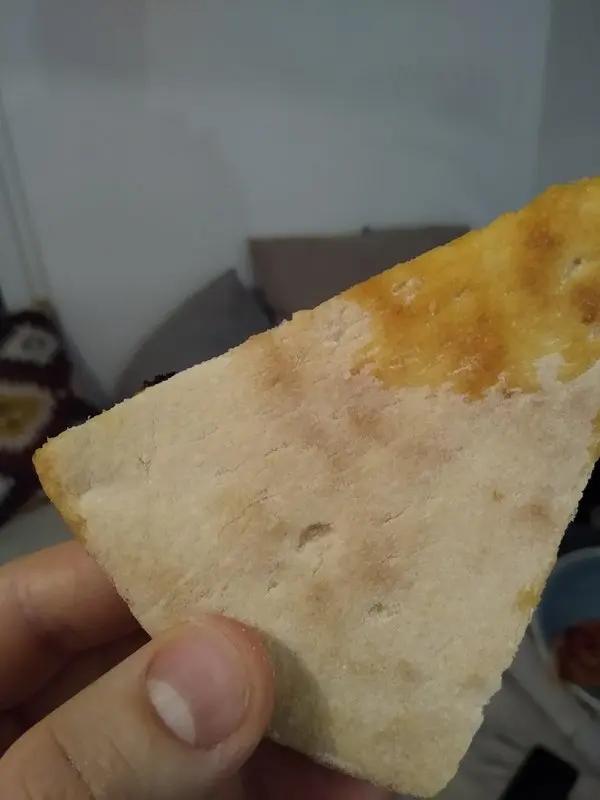
You like cooking pizza and have done some research to find out how to up your game. Everyone says you need a pizza stone or better still, a pizza steel. Pizza stones are half a quarter the price of steels, so stone it is. The image above is how they look, brand new.
So you order one, it arrives, and you cook on it and are expecting this:

Or this:

But instead, you’re getting this:

What’s going on?
A few months ago, I decided to get to the bottom of this mystery.
The Beginning
When I first bought two pizza stones for about 8 quid each, I did my due diligance to ensure they would have a long, productive life. The instructions (in the form of one tiny piece of paper) instructed to wash in warm, soapy water when first bought, then clean as needed (i.e. if dirty). No mention of any need to season or anything like that. No text in bold proclaiming NEVER WASH WITH ANYTHING OTHER THAN WATER!!! as some people on the internet will state. So I followed these instructions.
Over the next few months, as I used them I kept thinking that they were hardly any better than the previous bog standard, circular baking trays I’d been using. It was starting to irritate me. Every now and then, I’d have a look on the net and the solutions seemed to be:
- Domestic ovens can’t get hot enough
- You need a pizza steel
- Something is wrong with your dough
None of these are helpful in the slightest. I’m not changing my oven. I didn’t want a pizza steel as the stone was so disappointing. My dough is fine, thank you!
Improving Heat Transfer
Then, I stumbled on this video: Why Pizza Steels Beat Pizza Stones. The steel does beat the stone, but not by a massive amount:

My stones have never got close to anything like that. Yes, you can see that the steel does give better browning, even some leoparding in places. But I’d have been delighted with the crust / bottom of the stone baked one.
Look at this screenshot I took at about 06:40 into the video:

Look at the reflection on that stone! They’re not supposed to look like that. The reason it’s reflecting light is due to over ten years of use. All that oil, cheese, other stuff, seeping into the stone, getting hot and solidifying (curing). The whole video is worth watching, but I didn’t want to wait ten years to get mine like that…
Seasoning with Oil
So now I had a clue what would help, I got to work. I figured it should be similar to seasoning a wok, griddle, dutch oven. Essentially, you’re forming a layer of glaze for want of a better word that’ll transfer heat more effectively. Stone is highly porous, so I knew it’d take a few applications1.
Here’s what I did:
- Pour about a teaspoon of oil into the middle of the stone2
- Using your hand, spread the oil evenly all across the cooking surface
- Wait half an hour (most oil will have been absorbed)
- Go to step 1
- Repeat steps 1 to 4 five times
- Place in oven and cook on full for at least half an hour
- Leave to cool
- Back to step 1
Repeat that lot whenever you can be bothered. I did this maybe twice a week for about four weeks. Here’s how they look now:



Not bad for a few weeks!3
Once you’ve got your stone to this state, you won’t need to apply a teaspoon of oil any more, or follow the seasoning steps. Instead, get a piece of kitchen roll, put a small amount of oil on it and wipe the surface before cooking on it.
Conclusion
If you want a great pizza crust / bottom, you’ll either need to do this, or get a steel (or wait ten years). I’ve since bought a steel and it’s true, they are fantastic. But, your stone can still compete with the new guy, if you follow this method. My stones aren’t going anywhere.
Afterword
The next time I do a pizza on one of these stones, I’ll add a photo below. Have fun!
Well, here is a demonstration of what you can expect. To be fair, I probably should have given this one another couple / three minutes in the oven. By the way, where the underneath looks white, that’s flour. I was getting some sticking while rolling it4, so had to put more on than I normally do!


Footnotes
1 If you search for “season pizza stone with oil”, they’ll often do one application and call it a day. Not enough. You need the stone to absorb lots of oil. You’ve got to get that glazed, reflective finish!
2 I use sunflower oil. Vegetable oil should be fine. Olive oil if you’re rich (£5 + per bottle)!
3 I should point out that these weren’t new stones. I’d been using them for about a year before seasoning using the method I’m detailing here. The majority of the cooking surface was still the original cream colour.
4 I’m doing a post about rolling pizza soon.